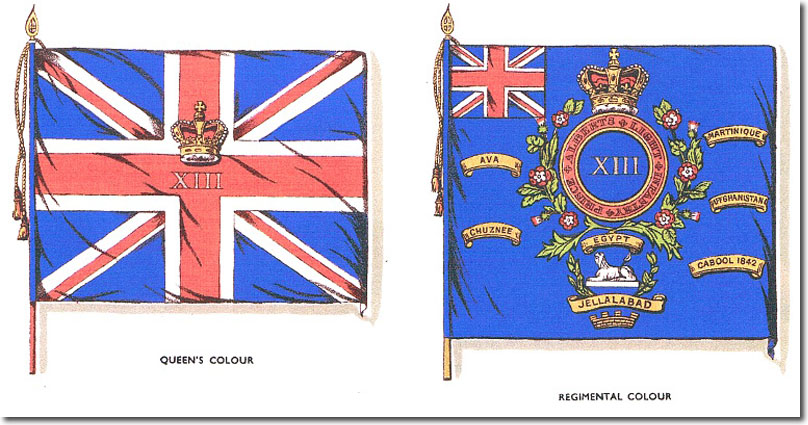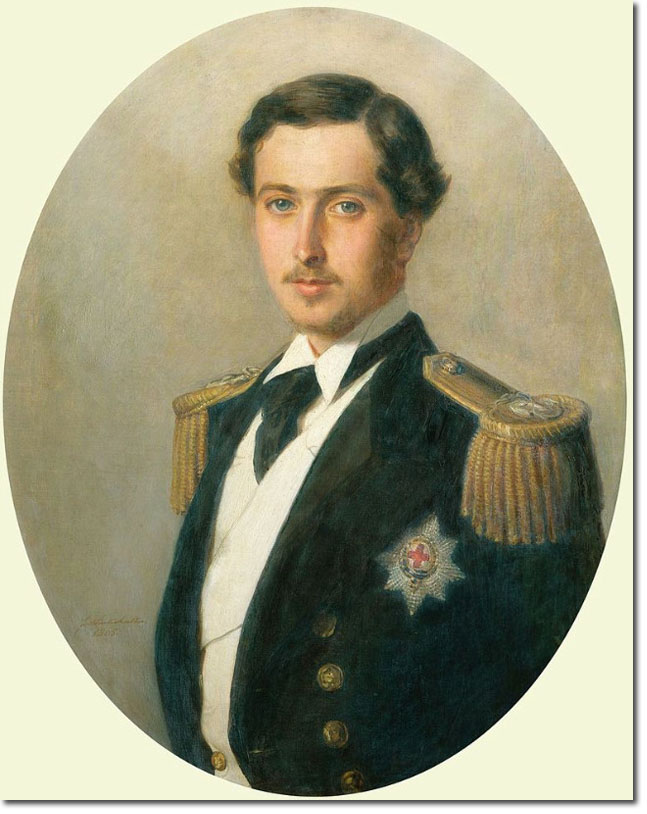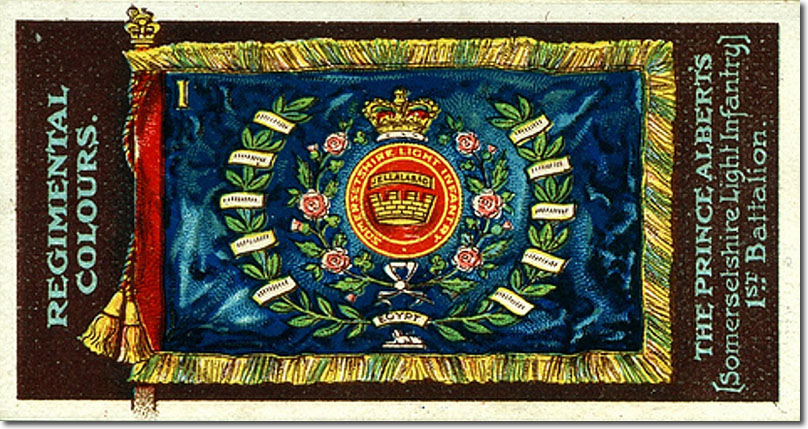|
|

| 1685 | The Colonel's flag was plain yellow. Lieut-Colonel's flag, yellow with St George's cross edged white. Major's the same with a red pile wavy. The other captains had the same as the lieut-colonel without any distinguishing marks. |
| 1702 | Around this time the Colours were reduced from one per company to 3 per regiment. |
| 1707 | The Union of Scotland and England took place and the cross of St Andrew was added to the cross of St George. The Lieut-Colonel's flag was the Union Flag and the Colonel's flag now had a small Union flag in the upper canton. The centre of the Colonel's yellow flag also showed his armorial bearings. The Colours were paid for by the Colonel of the regiment. |
| 1743 | The Warrant of 1743 ordered that the Colonel's arms may no longer be emblazoned on the Colours. The Union Colour was to be the first (King's) Colour and the second (Regimental) Colour to be in the facing colour of the regiment (yellow) with the union in the upper canton. In the centre of each Colour was to be the number of the rank of the regiment in gold Roman numerals (XIII) within a wreath of roses and thistles on one stalk. This was the first time that the regiments were officially numbered and indicated on any part of regimental equipment. These changes were reiterated in the orders of the Adjutant-General in 1749. |
| 1751 | The Royal Warrant of 1 July 1751 directed the facing colour of the 13th Regiment to be philemot yellow (feuille morte). Dimensions 6 ft 2 ins square. Length of pike (spear and ferrule included) 9ft 10 ins. Length of spearhead 4 ins. cords and tassels 3ft 4ins. Cords and tassels to be gold and crimson. |
| 1801 | The Union of Britain and Ireland in 1801 brought about another change in the Union flag; the red saltire of St Patrick, and the addition of shamrocks to the union wreath of roses and thistles. The 13th's involvement in the campaign at Aboukir Bay and Alexandria brought the battle honour EGYPT and the Sphinx which was officially sanctioned on 6 July 1802. |
| 1817 | New Colours were presented to the regiment on 24 May 1817 when they were in Jersey. The parade was in Fort Regent Square and they were consecrated by the Rev George Lawrence. A change was made to the Regimental Colour in that the heart-shaped shield, on which the XIII was placed, was abolished and replaced by a girdle of silk having inscribed upon it the county title. Within the girdle, on red silk was the regimental number 13 over 'Regt.' |
| 1846 | The Colours which were presented to the regiment on 13 Aug 1846. The facing colour changed from yellow to blue as the 13th had become Prince Albert's Light Infantry thus making them a 'Royal' regiment. AFGHANISTAN and GHUZNEE were awarded on 18 July 1840. JELLALABAD and the Mural Crown were awarded on 20 Aug 1842, and CABOOL 1842 was awarded on 22 June 1844. An order of 1844 stated that battle honours should only be borne on the Regimental Colour, not on the Queen's Colour. The size was 6ft 6in flying by 6ft on the pike. The regiment was presented with the new Colours by Prince Albert. This took place on Southsea Common, Portsmouth. The Prince sailed over from Osborne House in the Royal Yacht, landing at King's Stairs. He was received by Admiral Sir Charles Ogle Bt and Major-General Hon Sir Hercules Packenham. Albert inspected the regiment on horseback before the Colours were consecrated by the Chaplain-General to the Forces, Rev G R Gleig. The Colours were handed to the Prince by Lt-Col C T Van Straubenzee and Major Meredith and he presented them to the two senior ensigns, J D Longden and Melville Browne. The Colours were trooped as the band played 'The Grenadiers' slow march. |
| 1859 | On 21 Feb 1859 the Colours for the Second Battalion, raised in 1858, were presented by Prince Albert. The parade took place at a spot in the hills near Blackwater, 6 miles from Aldershot. The slopes of the hills were covered in soldiers from 3 Infantry Brigades and a Cavalry Brigade. Also present were the cadets from Sandhurst College. The hills were shaped like an amphitheatre and the 13th Light Infantry were paraded on level ground in the middle. The Colours were consecrated by the Chaplain-General Rev G R Gleig. Brevet Lieut-Col Hon A M Cathcart and Brevet Major Carr handed over the new Colours to His Royal Highness and he presented them to Ensigns William Moffett and Lloyd P Jenkins. The size of the Colours was 4ft 6in flying by 4ft. |
| 1864 | In1864 the 1st Battalion were at Dover when they were presented with new Colours by HRH Prince Alfred. His father, Prince Albert, had died in Nov 1861 and Prince Alfred, aged 20, attended in Naval uniform. Lord Mark Kerr gave the Colours to the Prince who presented them to Ensigns Middleton and Barker. Prince Alfred was the 4th child of Queen Victoria and Prince Albert, born 6 Aug 1844. He was known as the Duke of Edinburgh from 1866, and the Duke of Saxe-Coburg and Gotha from 1893. He served in the Royal Navy from 1858, and held the rank of Lieutenant when he presented the Colours to the 13th Somersetshire Prince Albert's Light Infantry in 1864. The painting by Winterhalter was completed in 1865. He made a round-the-world trip while in command of HMS Galatea and was the first member of the Royal Family to visit Australia. While there he was seriously injured in an assassination attempt in Sydney on 12 Mar 1868. He held several important C-in-C posts culminating in Admiral of the Fleet in 1893. He died on 30 July 1900. |
| 1881 | Changes were made to the Colours in that the small union flag in the upper canton of the Regimental Colour was abolished and the Queen's Colour was to have the territorial title on a circular device in the centre with the crown above. The size of the Colours had been reduced in 1868 to 3ft 9in flying and 3ft deep. |
| 1882 | On 20 Sep 1882 the regiment were awarded the battle honour DETTINGEN. |
| 1895 | On 23 May 1895 new Colours were presented to the 2nd Battalion at South Raglan Barracks, Devonport. HRH the Duke of Cambridge, Commander-in-Chief presented the Colours to Lieutenants Cooke-Hurle and Foord. The old Colours were deposited in St Mary's Church, Taunton on 19 July 1895. |
| 1896 | On 17 June 1896 a piece of the old Regimental Colour, which had been laid up in 1846, fell from it's pole in Canterbury Cathedral and was found by an ex-officer who realised that putting them back on the Colour was impossible, and informed the regiment. By rights it should have been destroyed, but it was accepted with gratitude by Lt-Col Borton because it was the centre of the Colour with the title and the honour MARTINIQUE. It was placed in a glass case as a prized piece of regimental history. |
| 1899 | . This cigarette card, published in 1899, depicts the 1st Battalion Regimental Colour, conforming to the 1881 regulations which abolished the small union flag in the upper canton. They were also ordered to arrange the battle honours on a wreath that encircled the central device. The red centre has the Mural crown and scroll for JELLALABAD but no stringed bugle. The title of the regiment encircles this with Victoria's crown above and a wreath of roses, thistles and shamrocks around it. The battalion number is in the upper canton as a Roman numeral. The battle honours on the laurel wreath are arranged, five on each side with EGYPT and the Sphinx at the base. The Colour is as described by Chichester and Burges-Short in their book Records and Badges of the British Army published in 1895 and revised in 1900. But their 1900 edition lists eleven battle honours including the two already mentioned here. That would make an uneven distribution of four on one side and five on the other. In 'Records' the honours listed are: DETTINGEN, EGYPT, MARTINIQUE, AVA, AFGHANISTAN, GHUZNEE, JELLALABAD, CABOOL 1842, SEBASTOPOL, SOUTH AFRICA 1878-9, BURMA 1885-7. Dettingen had been added retrospectively in 1882, and one more retrospective honour was added before 1914. This was GIBRALTAR 1704-5. The date of this addition is unclear. 'Records' has no knowledge of it but it was definitely listed before World War 1. The Ewart Committee of 1909 recommended this honour for the Grenadier and Coldstream Guards but I can find no mention of it for the Somerset Light Infantry. This means that either the honour was granted around 1899 and 'Records' failed to include it, or the artist who deigned this cigarette card got it wrong.. |
| 1907 | The Regiment were awarded an alteration to a battle honour on 1 Sep 1907. This was GHUZNEE 1839. The original honour was GHUZNEE awarded on 18 July 1840. |
Armed Forces | Art and Culture | Articles | Biographies | Colonies | Discussion | Glossary | Home | Library | Links | Map Room | Sources and Media | Science and Technology | Search | Student Zone | Timelines | TV & Film | Wargames